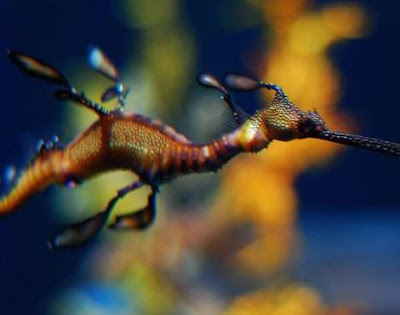Animals Unique | Sea Dragon Unique | The sea dragon is a small, delicate fish found in the tropical coastal waters of south and west Australia. Sea dragons look similar to and are in fact closely related to sea horses.
There are two different species of sea dragon the which are the Leafy sea dragon and the Weedy sea dragon. Although both sea dragon species have a similar body shape and size, They are very different in appearance.
The Leafy sea dragon is the master of camouflage, and being Able to hide Itself so easily amongst the plants That means the Leafy sea dragon is rarely eaten, Despite having Numerous potential predators in the surrounding water.
The Weedy sea dragon does not look so elaborate, only having a few feather fins along its back. The Weedy sea dragon has adapted to life on the sea bed as these feathery (weed-like) fins help the sea dragon to camouflage into the debris on the sea floor.
The Weedy sea dragon does not look so elaborate, only having a few feather fins along its back. The Weedy sea dragon has adapted to life on the sea bed as these feathery (weed-like) fins help the sea dragon to camouflage into the debris on the sea floor.
Despite Their small size, sea dragons are Carnivorous animals and therefore have a purely meat-based diet. The sea dragon uses its pipe-like snout to suck its prey into its oddly tooth-less mouth. Sea dragons hunt crustaceans, plankton, shrimp and even small fish, using camouflage to Their Their advantage.
Numerous sea dragons have natural predators in the south and western coastal waters of Australia but are rarely spotted even to the elaborate camouflage of the sea dragon. Those are few sea dragons That Unlucky enough to be found, are usually spotted by large fish.
Numerous sea dragons have natural predators in the south and western coastal waters of Australia but are rarely spotted even to the elaborate camouflage of the sea dragon. Those are few sea dragons That Unlucky enough to be found, are usually spotted by large fish.
As with sea horses, it is the male sea dragon WHO care for the eggs once laid They have been by the female. The female lays around 250 eggs onto the long tail onto the long tail of the male sea horse. The eggs of the sea dragon can take up to 9 weeks to hatch and REMAIN in the care of the male sea dragon at all times.
The baby sea dragons are completely independent once They have hatched and feed on tiny particles in the water Hydra. It can take up to a year for the sea dragon babies to be nearly the size of the adult sea dragons.
The baby sea dragons are completely independent once They have hatched and feed on tiny particles in the water Hydra. It can take up to a year for the sea dragon babies to be nearly the size of the adult sea dragons.
Sea Dragon Unique Facts
Kingdom: Animalia
Phylum: Chordata
Class: Actinopterygii
Order: Syngnathiformes
Family: Syngnathidae
Genus: Phycodurus
Common Name: Sea Dragon
Scientific Name: Phycodurus Eques
Origin: Australian coastal waters
Diet: Carnivore
Size (L): 20cm - 24cm (10in - 12in)
Water Type: Salt
Optimum pH Level: 6.5 - 8.0
Life Span: 2-10 years
Conservation Status: Threatened
Colour: Brown, Black, Yellow, White, Tan, Grey, Green, Red, Orange
Skin Type: Scales
Favourite Food: Plankton
Habitat: Tropical coastal waters
Average Clutch Size: 250
Main Prey: Plankton, Shrimp, Small fish
Predators: Large Fish
Distinctive Features: elongated snout and easily camouflaged body
Kingdom: Animalia
Phylum: Chordata
Class: Actinopterygii
Order: Syngnathiformes
Family: Syngnathidae
Genus: Phycodurus
Common Name: Sea Dragon
Scientific Name: Phycodurus Eques
Origin: Australian coastal waters
Diet: Carnivore
Size (L): 20cm - 24cm (10in - 12in)
Water Type: Salt
Optimum pH Level: 6.5 - 8.0
Life Span: 2-10 years
Conservation Status: Threatened
Colour: Brown, Black, Yellow, White, Tan, Grey, Green, Red, Orange
Skin Type: Scales
Favourite Food: Plankton
Habitat: Tropical coastal waters
Average Clutch Size: 250
Main Prey: Plankton, Shrimp, Small fish
Predators: Large Fish
Distinctive Features: elongated snout and easily camouflaged body






No comments:
Post a Comment